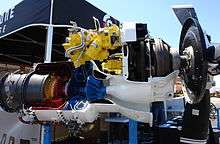Honeywell TPE331
| TPE331 / T76 | |
|---|---|
_TPE331-14.jpg) | |
| TPE331-14 | |
| Type | Turboprop |
| National origin | United States |
| Manufacturer | Garrett AiResearch Honeywell Aerospace |
| First run | 1960 |
| Major applications | Fairchild Swearingen Metroliner Mitsubishi MU-2 Rockwell Turbo Commander |
| Number built | 13,500+[1] |
The Honeywell TPE331 (military designation: T76) is a turboprop engine originally designed in the 1960s by Garrett AiResearch, and produced since 1999 by Honeywell Aerospace, after AlliedSignal acquired Honeywell, keeping the Honeywell name. The TPE331 family includes 18 models and 106 configurations; the engines range from 575 to 1650 shaft horsepower (shp).[2][3][4]
Design and development
Garrett AiResearch designed the TPE331 from scratch in 1959 for the military.[5] “Designed as a 575-horsepower engine it was not a scaled-down version of a larger engine, as competitors were offering.” [Out of Thin Air, 153] The TPE331 originated in 1961 as a gas turbine (the "331") to power helicopters.[6] It first went into production in 1963.[7] More than 700 had been shipped by the end of 1973.[8] It was designed to be both a turboshaft (TSE331) and a turboprop (TPE331), but the turboshaft version never went into production. The first engine was produced in 1963, installed on the Aero Commander in 1964 and put into production on the Aero Commander Turbo Commander in June 1965.[9]
Performance
The 715 shp TPE331-6 used in the Beech King Air B100 have a 400-hr. fuel nozzle cleaning interval, 1,800-hr. hot section inspection interval and a 5,400-hr. time between overhaul; approval is possible for 3,000-hr. HSIs and 6,000-hr. overhauls and engine reserves are cheaper than for the PT6A with $130,000 HSI checks and $190,000 overhauls.[10]
Applications
- Aero/Rockwell Turbo Commander 680/690/840/960/1000
- Antonov An-2
- Antonov An-38
- Ayres Thrush
- BAe Jetstream 31/32
- British Aerospace Jetstream 41
- Beech B100 King Air
- CASA C-212 Aviocar
- Cessna 441 Conquest II
- Comp Air 9
- Conroy Stolifter
- Dornier Do 228
- Fairchild Swearingen Metroliner
- General Atomics MQ-9 Reaper
- Grob G 520
- HAL HTT-40
- Kestrel K-350
- Mitsubishi MU-2
- North American Rockwell OV-10 Bronco
- Pilatus/Fairchild PC-6C Turbo-Porter
- Piper Cheyenne 400
- Short SC.7 Skyvan
- Short Tucano
- Swearingen Merlin
Fitted with TPE-331s as a replacement for their original engines
Specifications

General characteristics
- Type: Single-shaft turboprop with integral gearbox
- Length: 46 in (1168 mm) (TPE331-43A),[11] 42.82 in (1,088 mm) (TPE331-10)[12]
- Diameter: 21 in (533 mm) (TPE331-43A)[11]
- Dry weight: 336 lb (153 kg) (TPE331-43A),[11] 385 lb (175 kg) (TPE331-10)[12]
Components
- Compressor: Two-stage centrifugal
- Combustors: Reverse annular
- Turbine: Three-stage axial
Performance
- Maximum power output: 575 hp (429 kW)(TPE331-43A),[11] 940 hp (700 kW) (TPE331-10)[12]
- Overall pressure ratio: 10.55 (TPE331-10)[12]
- Specific fuel consumption: 0.534 lb/(hp⋅h) (325 g/kWh) per hour (TPE331-10)[12]
- Power-to-weight ratio: 1.71 hp/lb (2.8 kW/kg) (TPE331-43A),[11] 2.44 hp/lb (4.01 kW/kg) (TPE331-10)[12]
See also
Comparable engines
Related lists
Note
^ These aircraft were fitted with TPE-331s as a modification to replace their original engines
References
- ↑ "Honeywell Continues to Hone Turboprop Engine for 50th Anniversary" (Press release). Honeywell. July 2016.
- ↑ "Honeywell Aerospace TPE331 Spec Chart" Honeywell. Accessed: 29 August 2014.
- ↑ "TPE". Honeywell Aerospace. Archived from the original on September 8, 2010.
- ↑ "TPE331-14 Turboprop Engine" Honeywell. Accessed: 29 August 2014.
- ↑ "TPE331 Engines Offers Super Performance on Dornier 228 Aircraft" (Press release). Honeywell. April 2017.
- ↑ William A. Schoneberger and Robert R. H. Scholl, Out of Thin Air: Garrett's First 50 Years, Phoenix: Garrett Corporation, 1985 ( ISBN 0-9617029-0-7), pp. 174–5.
- ↑ Canadian Museum of Flight, "Garrett TPE331"
- ↑ Schoneberger and Scholl, p. 203.
- ↑ Leyes, p. 725
- ↑ Fred George (Jan 30, 2017). "Used Aircraft Report: Beech King Air B100". Business & Commercial Aviation. Aviation Week.
- 1 2 3 4 5 Canadian Museum of Flight "Garrett TPE331-43A"
- 1 2 3 4 5 6 "TPE331-10 Turboprop Engine" (PDF). Honeywell. April 2006.
External links
| Wikimedia Commons has media related to Honeywell TPE331. |